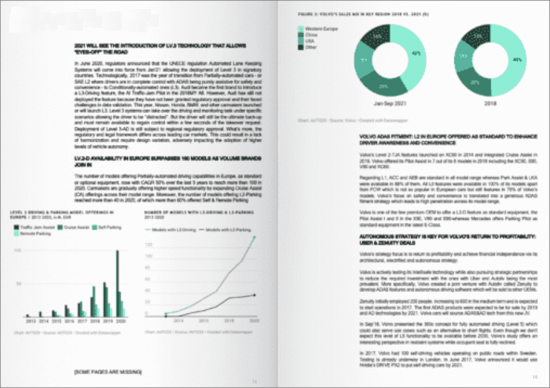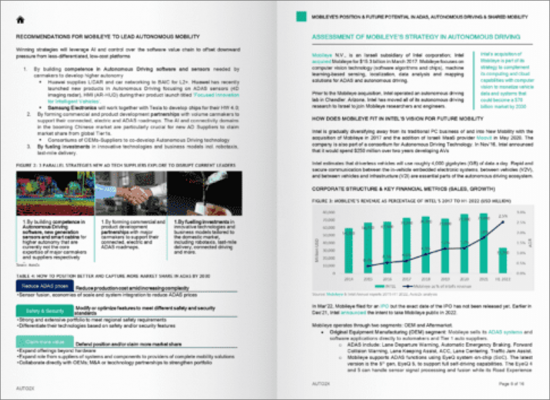 |
市場調査レポート
商品コード
1302349
インテリジェントセキュア自動運転車(2040年)Intelligent, Secure & Autonomous Car of the Future 2040 |
||||||
| インテリジェントセキュア自動運転車(2040年) |
|
出版日: 2023年05月19日
発行: Auto2x
ページ情報: 英文 450 Pages; 423 Tables & Graphs
納期: 即日から翌営業日
|
- 全表示
- 概要
- 目次
当レポートでは、自動運転車展開の現在と将来(~2025年)の状況を検証し、乗用車の自動運転の商業化に向けた、主要自動車メーカー30社の戦略と技術ロードマップを分析しています。
サンプルビュー


目次
第1章 自動運転ロードマップ
- ADAS・AD市場(2025年)
- ADASセンサーの普及
- 主要自動車メーカーのAD戦略
- L2~L4の普及(2025年)
第2章 ADASの主要Tier 1サプライヤー
- ADASの収益(2020年~2025年)
- レーダー、カメラのシェア
- Tier 1上位10社のADAS能力によるランキングと市場シェア
第3章 自律性、V2X、サイバーセキュリティに関する規制
- 主要市場におけるL3~4への規制の障害
- UNECEにおけるALKS規制
- 米国の任意ガイドライン
- 自動車サイバーセキュリティ規制
- AI規制
第4章 自動車サイバーセキュリティ(2025年):セキュアコネクテッド
When will automated driving technology & regulation converge to allow the first Level 3 & Level 4 cars to hit the road?
How do leading carmakers plan to commercialize Level 4-Automated driving?
We examine the current & future status of automated vehicle deployment until 2025 and analyze the strategy & technological roadmaps of 30 leading carmakers to commercialize automated driving for passenger cars. This report portfolio is a complete guide to the Car of the Future.
SAMPLE VIEW


Carmakers have unveiled their vision for the Autonomous Car of the Future but today's technology is still "Highly-Assistive" rather than Autonomous
Today, drivers enjoy longitudinal and/or lateral driving assistance (SAE Level 0-2) in both parking and cruising scenarios. Conditional eyes-of-the-road (Level 3) is not permitted by regulation and traffic laws in Europe and China which has delayed or changed carmakers' strategies.
Carmakers have unveiled their vision of Level 5 autonomy with concepts designed from the ground up to take advantage of it (e.g. side tasks). But engineering challenges to reach higher autonomy, regulatory approval to allow deployment and consumer adoption stand in the way.
Geo-fenced L4 in Automated-Mobility-on-Demand was launched in 2019 by Waymo but deployment in private cars follows a different roadmap.
"Revenues from ADAS & Automated Driving will reach €35 Billion due to the increase in sensor content, says Auto2x"
Carmakers' strategies and business models to democratize the Car of the Future
Autonomous Driving, Software-Defined Vehicles, Automotive Cyber Security, Zero-emission powertrains and Circular Autos, are some of the major requirements for the car of the future.
Cars are becoming Software-Centric which creates opportunities and challenges in development cost, complexity, security and monetization
One of the biggest challenges for the Car of the Future is the vast amount of data that is produced-and will exponentially increase as vehicles become increasingly autonomous and connected and are required to process vehicle-to-vehicle and vehicle-to-infrastructure communications.
SDV create new opportunities to reduce the complexity from the rise of features and variants, accelerate feature development time, streamline costs and enable SOTA updates on demand.
Lower software development cost is key for faster and more efficient automotive development. Re-usable software platforms are needed to lower development costs.
Finally, Android Automotive OS will become the mainstream operating system enabling carmakers to offer intuitive HMI and 3rd parties to integrate connected services.
Chinese Carmakers are catching up with global leaders in Level 2 and 3
Chinese carmakers leverage their strategic partnerships with foreign OEMs and domestic tech pioneers to mass-deploy their autonomous parking capabilities that rival Audi, BMW, Mercedes-Benz and Tesla. The following vehicles provide point-to-point memory parking by integrating visual SLAM and ultrasonic radars to memorize and learn commonly used parking spaces and driving routes.
- ORA's full-scene Automatic Parking system,
- BYD's Vision Fusion Automatic Parking,
- Geely's FOTA and 5G Autonomous Valet Parking,
- Changan's APA 5.0 Remote Control Valet Parking;
Chinese carmakers' efforts to enhance their ADAS portfolios and narrow the technological gap for Lv.2-Driving to Lv.4 is evident by the commercialization of their technologies.
- Changan's UNI series is equipped with Lv.3 Traffic Jam Pilot,
- Geely's Xingyue is equipped with G-Pilot 4 that offers L2+ and high-speed AEB-CUI,
- GAC's Aion series is equipped with ADiGO 3.0 driving assistant package that provides hands free driving experience under specific scenarios.
The approval of Level 3 automation will allow greater utilisation of the time spent inside the car
The car of the future needs to be Autonomous, Digital, and Circular. New business models arise to monetise the new opportunities in automotive insurance, such as Pay-As-You-Drive insurance, and in-vehicle infotainment, e.g. video-on-demand.
However, the commercialisation of Level 3 is uncertain given the high cost/benefit ratio, i.e. the marginal impact on safety and driver convenience from L2 compared to the massive engineering challenge. Hence, carmakers are taking different approaches to reach L4 in an attempt to gain a competitive advantage and reshape profitability.
What is more, L4/fully-automated vehicles will revolutionise transportation and mobility leading to what we call Intelligent Mobility. This includes the rising car-sharing and ride-sharing businesses as well as new vehicle ownership models in the Passenger Car market.
However, we assess that the impact on the Commercial Vehicle market will be even greater (with features such as platooning) therefore more and more carmakers shift their focus on or try to enter the mass transit and CV market. For example, Ford is now branded as a mobility company whereas Uber acquired Otto which is working on the first self-driving truck.
Finally, L4 will cause a shift in industry profits. If carmakers do not embrace tech change and invest in SW they face being merely assemblers.
Regulations shaping engineering requirements for the Car of the Future
After almost 3 years in the making, the amendment of UNECE Reg. No.79-Steering Equipment will allow Level 3 in countries adopting the new rules called "Automated Lane Keeping System". In Jun'20, the UN announced the ALKS regulation which is set to apply to 60 countries including the UK, Japan, and European Union member states from January 2021, to enable the safe introduction of 'Level 3' automation features in certain traffic environments.
UN regulations manage pre-sale Type Approval, i.e. the Regulation sets out clear performance-based requirements that must be met by car manufacturers before ALKS-equipped vehicles can be sold within countries mandating the Regulation.
UNECE's Automated Lane Keeping System regulation is applicable for LEVEL 3, for low-speed (60 km/h) highway-only.
Level 3-Conditional Automation presents challenges to motor insurance due to its implications for the determination of liability. Read how Event-Data-Recorders for Automated Driving modes could help the auto insurance industry to adapt to the disruption.
Protection against cyber-physical threats, security-by-design, needs to become a priority as higher automation and connectivity will augment the vehicle's attack vector.
The lack of harmonization of Autonomous Driving regulation across major car markets remains the key roadblock to the deployment of L3-4
Carmakers and developers of autonomous driving technology face compliance requirements that are different across major car markets. For example, for countries such as Japan, China and the EU members that are signatories of the UNECE regulation, there is no framework for type approval of Level 4. Germany, was one of the first countries globally to allow testing of L4 but this applies to robotaxis and autonomous shuttles, not private car ownership.
Automotive Cyber Security is a big concern that is still not addressed sufficiently for the Car of the Future
Voluntary guidelines can have an immediate effect, compared to a mandate that can take 4-8 years to come into force however, they do not offer the benefits of comments etc.
What is more, enforcement is weaker. The problem is that non-binding guidelines might fail to address one of the most important issues we are facing today: retrofitting vehicles on the road with more robust security. A clearer response to if and when NHTSA will make the Vehicle Performance Guidance mandatory, with retroactive effect, could help towards retrofitting & give a clear adoption roadmap to stakeholders
Over the next decade, as transportation progresses from Connected and Partially-Automated to Highly and Fully-automated, Smart and Shared Mobility, the addition of new sensors and ECUs, new architecture, more Connected devices and V2X will significantly enlarge the vehicle ''attack surface". Identifying, mitigating and responding to cyber threats will not only be paramount for physical road and vehicle safety but also a prerequisite for the transition towards self-driving cars.
Reg.No.157-ALKS will also need to comply with cyber-security and software update requirements set out in two other new U.N. regulations. Two new regulations on automotive cybersecurity and software updates to establish clear performance and audit requirements for OEMs are coming into effect in Jan'21.
- The 1st is the "UN Regulation on Cybersecurity and Cyber Security Management Systems";
- the 2nd the "UN Regulation on Software Updates & Software Updates Management Systems".
Table of Contents
1. Automated Driving Roadmaps
- ADAS & AD Market 2025
- ADAS sensor penetration
- Top Carmaker AD strategies
- L2-L4 penetration in 2025
2. Top Tier-1 Suppliers in ADAS
- ADAS revenue 2020-25
- Shares in radar, camera
- Rankings and market shares of Top-10 Tier 1s by competency in ADAS
3. Regulation for Autonomy, V2X & Cyber Security
- Regulatory roadblocks to L3-4 in major markets
- ALKS Regulation in UNECE
- USA's voluntary guidelines
- Automotive Cyber Security Regulation
- AI regulation
